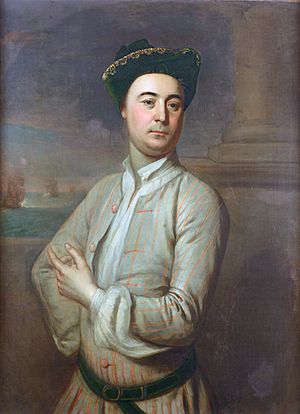Sir Robert Harland, 1st Baronet facts for kids
Quick facts for kids
Sir Robert Harland
|
|
|---|---|

Admiral Sir Robert Harland
|
|
| Born | ca. 1715 |
| Died | 21 February 1784 |
| Allegiance | |
| Service/ |
|
| Years of service | 1729–1783 |
| Rank | Admiral |
| Commands held | HMS Scipio HMS Tilbury HMS Nottingham HMS Monarch HMS Essex HMS Conqueror HMS Princess Louisa East Indies Station |
| Battles/wars | War of the Austrian Succession Seven Years' War |
Admiral Sir Robert Harland (born around 1715, died 1784) was a brave officer in the Royal Navy, the navy of Great Britain. He was known for leading ships in important battles.
He commanded HMS Tilbury during the Second Battle of Cape Finisterre in 1747. This battle was part of the War of the Austrian Succession. Later, he led HMS Princess Louisa at the Battle of Lagos in 1759, during the Seven Years' War.
Sir Robert Harland rose through the ranks. He became a top commander in the East Indies Station. He also held a very important job called First Naval Lord, helping to lead the entire British Navy.
Contents

Robert Harland followed in his father's footsteps. His father was also a Navy captain. Robert joined the Royal Navy in 1729 when he was about 14 years old. His first ship was HMS Falkland.
Early Ranks and First Battles
By 1744, Harland was a lieutenant. He was on HMS Princessa during the Battle of Toulon. In 1745, he got his first command, a fireship called HMS Scipio.
He was promoted to post captain in 1746. This meant he could command larger ships. He then took charge of HMS Tilbury. He led this ship in the Second Battle of Cape Finisterre in 1747.
Capturing a French Warship
Later in 1747, Harland commanded HMS Nottingham. In 1748, his ship played a big part in capturing a large French warship. This French ship was the 74-gun Magnanime. Capturing such a powerful ship was a major success.
Leading More Ships
Over the next few years, Harland commanded several other ships. These included HMS Monarch (from 1748) and HMS Essex (from 1755). In 1758, he took command of HMS Conqueror.
In 1759, he moved to HMS Princess Louisa. He led this ship in the Battle of Lagos on August 18, 1759.
Rising to Admiral
Harland continued to advance in his career. He was promoted to rear-admiral in 1770. The next year, in 1771, he became the Commander-in-Chief of the East Indies Station. This was a very important role, overseeing British naval forces in a large area. He stayed in this position until 1775.
In 1771, he was also made a baronet. This is a special honor from the King. He became Sir Robert Harland, 1st Baronet.
He was promoted again to vice-admiral in 1776. He then became the second-in-command of the Channel Fleet. This fleet protected the waters around Great Britain. He fought in the Battle of Ushant in 1778.
In 1782, Sir Robert Harland joined the Board of Admiralty. This board was in charge of running the Royal Navy. He served as First Naval Lord from April 1, 1782. This was one of the most powerful positions in the Navy. He was promoted to full admiral shortly after. He left this role in January 1783.
Sir Robert Harland passed away at his home in Sproughton, Suffolk, on February 21, 1784.
Family Life
In 1749, Sir Robert Harland married Susanna Reynold. They had three daughters and one son together.
Sources
| Military offices
|
||
|---|---|---|
| Preceded by John Lindsay |
Commander-in-Chief, East Indies Station 1771–1775 |
Succeeded by Edward Hughes |
| Preceded by George Darby |
First Naval Lord 1782–1783 |
Succeeded by Hugh Pigot |
| Baronetage of Great Britain | ||
| New creation | Baronet (of Sproughton) 1771–1784 |
Succeeded by Robert Harland |

